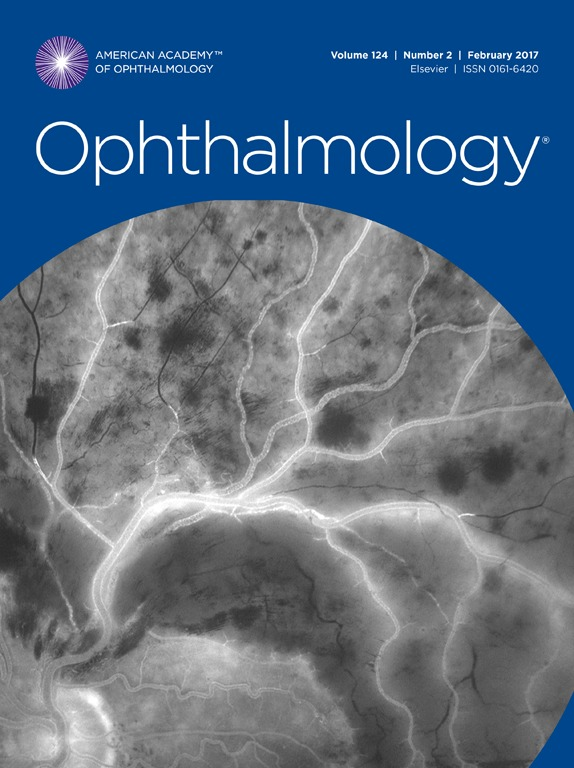Instrument-Based Screening for the Detection of Amblyopia and Amblyopia Risk Factors
IF 9.5
1区 医学
Q1 OPHTHALMOLOGY
引用次数: 0
Abstract
Purpose
To review the published literature on the diagnostic accuracy of instrument-based screening devices used to detect amblyopia and amblyopia risk factors (ARFs).
Methods
A literature search of the PubMed database with no date restrictions and limited to articles published in English was last conducted in January 2025. The search yielded 291 articles; 41 were reviewed in full text, and 33 met the criteria for inclusion in this assessment. The panel methodologist assigned a level of evidence rating to each of the included studies.
Results
All 33 articles (which reported results from 28 072 children) were rated level III. Nine screening devices were discussed in the included studies; the most common were the Plusoptix, Spot, and Retinomax. Results from 28 072 children were reported, and most studies focused on children aged 6 years and younger. The most common study setting was ophthalmology clinics, followed by school-based settings and then community-based settings. For detecting ARFs, sensitivity ranged from 32.3% to 100% and specificity ranged from 38.7% to 94% (Plusoptix sensitivity 32.3%–100%, specificity 38.7%–100%; Retinomax sensitivity 70%–95%, specificity 58%–94%; Spot sensitivity 60%–94%, specificity 67%–97%). Examination failure thresholds varied, but most studies after 2013 followed the 2013 American Association for Pediatric Ophthalmology and Strabismus (AAPOS) guidelines. For the 21 studies that reported the referral rate (percentage of children who failed based on the screening result), the rate varied significantly (2.26%–63%). Higher referral rates were seen in studies based in ophthalmology clinics.
Conclusions
The best available evidence supports the use of instrument-based screening devices to detect amblyopia and ARFs, although there were high levels of variability in the study design, setting, and target age for screening. Additionally, diagnostic accuracy varied on the basis of the screening device used. Future studies of instrument-based screening devices would benefit from following standardized reporting measures for diagnostic accuracy, which will strengthen the evidence base and provide more complete data on which to base decisions about the most appropriate screening programs and strategies.
Financial Disclosure(s)
Proprietary or commercial disclosure may be found after the references.
基于仪器的弱视筛查和弱视危险因素检测:美国眼科学会报告。
目的:回顾已发表的有关仪器筛查装置检测弱视及弱视危险因素诊断准确性的文献。方法:对PubMed数据库进行文献检索,检索时间为2025年1月,无日期限制,仅限于发表的英文文章。搜索产生了291篇文章;全文审查了41个,33个符合列入本评价的标准。小组方法学家为每项纳入的研究分配了一个证据等级。结果:所有33篇文章(报告了28072名儿童的结果)均被评为III级。在纳入的研究中讨论了九种筛选装置;最常见的是Plusoptix、Spot和Retinomax。报告了28072名儿童的结果,大多数研究集中在6岁及以下的儿童身上。最常见的研究环境是眼科诊所,其次是学校环境,然后是社区环境。检测arf的灵敏度32.3% ~ 100%,特异性38.7% ~ 94% (Plusoptix灵敏度32.3% ~ 100%,特异性38.7% ~ 100%;Retinomax灵敏度70% ~ 95%,特异性58% ~ 94%;Spot灵敏度60% ~ 94%,特异性67% ~ 97%)。检查失败阈值各不相同,但2013年之后的大多数研究遵循2013年美国儿童眼科和斜视协会(AAPOS)指南。在报告转诊率(根据筛查结果未通过的儿童百分比)的21项研究中,转诊率差异显著(2.26%-63%)。在眼科诊所的研究中发现了更高的转诊率。结论:现有的最佳证据支持使用基于仪器的筛查设备来检测弱视和ARFs,尽管在研究设计、设置和筛查的目标年龄方面存在很大的差异。此外,诊断的准确性根据所使用的筛查设备而有所不同。基于仪器的筛查设备的未来研究将受益于以下诊断准确性的标准化报告措施,这将加强证据基础,并提供更完整的数据,以确定最合适的筛查方案和策略。财务披露:在参考文献之后可能会发现专有或商业披露。
本文章由计算机程序翻译,如有差异,请以英文原文为准。
求助全文
约1分钟内获得全文
求助全文
来源期刊

Ophthalmology
医学-眼科学
CiteScore
22.30
自引率
3.60%
发文量
412
审稿时长
18 days
期刊介绍:
The journal Ophthalmology, from the American Academy of Ophthalmology, contributes to society by publishing research in clinical and basic science related to vision.It upholds excellence through unbiased peer-review, fostering innovation, promoting discovery, and encouraging lifelong learning.
 求助内容:
求助内容: 应助结果提醒方式:
应助结果提醒方式:


